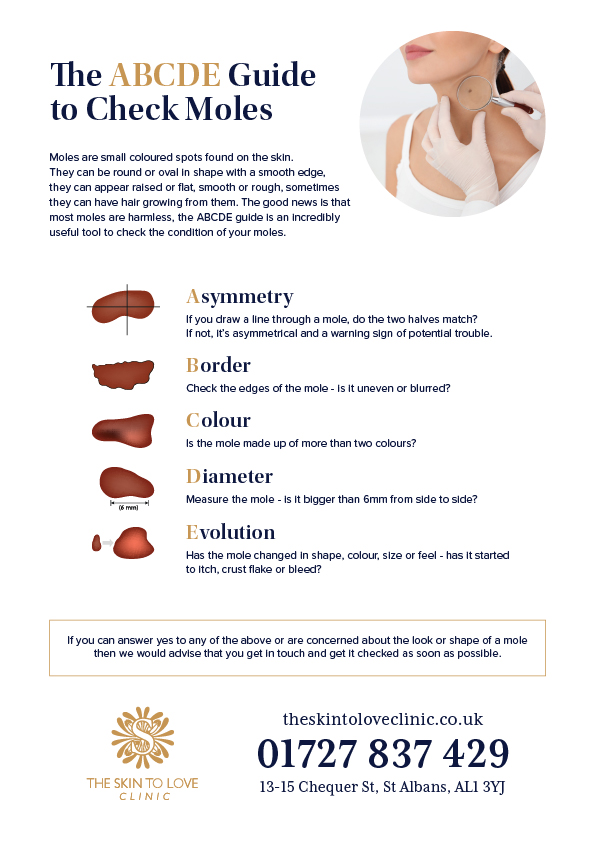To enlarge the infographic, please click here.
It’s Sun Awareness Week in May, but here at the Skin to Love Clinic we think it’s never too early to start raising awareness of the dangers of UV light from the sun. Our mantra, whatever your age or the colour of your skin is – protect, protect, protect! Avoid the sun, wear a large sun hat if you’re on holiday, and frequently reapply your sun cream with a 30 to 50 SPF or 15 to 30 SPF for skin of colour. Sun damage and UV exposure can cause premature ageing, lead to pigmentation, and can increase the chance of a mole becoming cancerous. So, we thought it was time to talk about moles, how to check your skin for them, what to look out for and when to take action.
Moles are small coloured spots found on the skin. They can be round or oval in shape with a smooth edge, they can appear raised or flat, smooth or rough, sometimes they can have hair growing from them. The good news is that most moles are harmless, it’s completely normal to be born with them, and equally normal to develop new ones during childhood and adolescence, moles can disappear over time and can become darker particularly during pregnancy.
So, how can these seemingly harmless skin spots be a cause for trouble? And who is most a risk? The problem with moles is that they can change. Changes can take place over weeks or months. In some cases, they can develop into a melanoma, a type of skin cancer which is currently the third most common in the UK. Found early and dealt with speedily, the outcome is positive which is why we encourage regular mole checks.
But who is at risk? If you’re fair skinned, boast a lot of freckles or moles and burn easily or if a family member has had a melanoma then you need to be extra vigilant, but remember whatever your skin type you need to keep watch.
The ABCDE guide is an incredibly useful tool to check existing or new moles:
A – Asymmetry – if you draw a line through a mole and the two halves don’t match then it’s asymmetrical and a warning sign of potential trouble. If your moles are symmetrical, usually this is no cause for concern.
B – Border – check the edges of the mole, is it uneven or blurred?
C – Colour – is the mole made up of more than two colours?
D – Diameter – measure the mole is it bigger than 6mm from side to side?
E – Evolution – has the mole changed in shape, colour, size or feel – has it started to itch, crust flake or bleed?
If you can answer yes to any of the above or are concerned about the look or shape of a mole then we would advise that you get it checked as soon as possible. At the Clinic we offer diagnostic services as well as treatments including a possibly life-saving mole screening service with our consultant dermatologist Dr Sharon Crichlow, so, if you are worried about a particular mole or just want to have the assurance that there’s nothing to worry about then call the clinic to book an appointment on 01727 837429 or click here to message us online. Please be aware that our blog is purely for information and is not a substitute for a mole check from a medical professional.
To enlarge the infographic, please click here.
Disclaimer: This blog is not to be used for diagnostic purposes. We are all unique which means that our results, recovery and suitability for any type of treatment will vary. Always seek the advice of a professional should you have any health or cosmetic concerns or to discuss treatments specifically for you.





